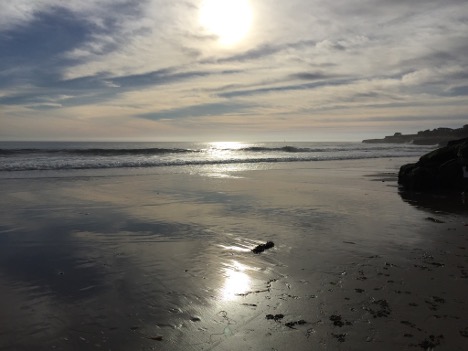These have been very full days. Last Wednesday the Novena of Grace began, which is a nine-day preached retreat in everyday life hosted by the Ignatian Spirituality Center where I work half-time as Program Coordinator. Essentially there are two services each day, midday and early evening, and participants can choose one to attend in the midst of their everyday life.
As a part of this service we offer prayers at the end with relics, which are tiny fragments of the remains of Saints, in this case Ignatian ones such as St. Francis Xavier and St. Ignatius of Loyola. The Catholic tradition is nothing, if not incarnational, in touch with the embodiment of human life. I find something so beautiful about this honoring of the physical, tangible connection to the Communion of Saints.
A week ago I had to go over to Seattle University where the relics are kept to pick them up. They are housed in small glass and metal cases with the name of the Saint and the relic itself contained within, no larger than the head of a pin. I am responsible these nine days for what are irreplaceable objects. I was handed a small box which held them snugly inside and I placed it gently into my backpack and headed to work. As I walked I was aware of the unusual circumstances of my situation, wandering the streets of Seattle with the remains of the Saints jostling in my backpack.
Along the way I stopped at Walgreens to pick up some Excedrin for a headache that had been building all morning. I walked through the aisles among mascara and foundation, toothpaste and deodarant with the relics at my side. I headed to the pain relief section and stood there in front of the massive array of choices to soothe the aches of human living. I wanted to make my selection quickly, so as to get the relics to their destination. Then I realized in a moment of grace and clarity, what better place for the Saints to be than here in Walgreens? These holy persons who walked the earth and had their own transformations. Ignatius of Loyola who knew intimately the profound physical pain of injury and also the doorway it can sometimes offer into something deeper.
Suddenly they were standing there with me, Francis and Ignatius. They were blessing me with my headache and backpack holding my cell phone, wallet, keys, and sacred bone fragments. They were blessing each bottle of pills, praying that those who purchased them would find relief in both body and spirit. They were blessing the other people who gathered for a brief few moments in that space with me — the elderly man shuffling along slowly looking for a card to express some heartfelt wish to a loved one, the very young girl who was skipping through the aisles asking her tired mother for candy, the tired mother who was just laid off from her part-time work that was keeping ends together and now looking at lipstick colors to grasp at some sense of her own beauty for a moment. I joined them in their blessings, singing them in my heart, showering them on everyone I saw.
I brought my bottle up to the counter. The woman checking out my purchase was cheerful, asking if I had seen their special on eye cream. I wanted to ask her if she had seen the Saints walking through Walgreens that day. I wanted to ask if she knew that this place was holy ground.
(c) Christine Valters Paintner at Abbey of the Arts:
Transformative Living through Contemplative & Expressive Arts







11 Responses
Thank you Christine. This posting was deeply moving. How beautifully this experience brought together the ordinary and the divine. I have very little understanding of relics as I come from a Protestant background. Your description of your connection – my connection – to the saints who have gone before us, made me pause. I felt their existence as stones that have fallen into the pond of eternity, the ripples of their falling reaching forward to stroke my soul with their own. I am blessed and able to join in the blessing of others.
LOVE this! Thanks so much. And interesting timing…today I just finished reading The Road to Canterbury by Shirley Du Boulay, a British writer who made a pilgrimage to Canterbury Cathedral. She writes of St. Thomas Becket, of course, and of the intertwining of the physical and spiritual aspects of the life of a saint, including the places (and parts!) connected with them. She became Roman Catholic as an adult and, not having grown up with an understanding of relics, had to do some work to figure out what she thought of them. (I’m a Methodist; I can relate!) In a section that I read today, she writes that in the midst of wrestling to understand the theology of it all, what she really finds accessible is “the idea that in essence the veneration of relics is based on the natural instinct to revere objects associated with the beloved dead. My house is filled with things I treasure because they were my husband’s. I keep old clothes I no longer wear simply because he gave them to me, house boxes of useless junk that he had never got round to throwing away, treasure a broken statue we once bought together. I know that it is absurd, that hanging on to possessions will not bring him back, but…I need them.”
Though hanging on to her husband’s possessions isn’t precisely the same thing as holding on to a body part, I appreciate how she writes about “the beloved dead” and also how the veneration of relics (which she points out is quite distinct from worshiping relics) emphasizes the incarnational aspect of the Christian tradition. She also mentions that “at a recent performance of [T. S.] Eliot’s Murder in the Cathedral…one of the front seats was occupied by a bone of St Thomas. It normally lives in the church safe, but makes occasional special appearances.” Wonder if it enjoyed the show…
Thank you again for this lovely piece, both elegant and deeply incarnational.
I really enjoyed reading about your sacred experience today. Not something you get to do every day. Quite a journey indeed. You should submit this as a short story for publication.
Thank you Tess, Eveline, Barbara, Suz, and lucy, I am delighted that I gave some of you a new window into relics! It was definitely a moment of transcendent vision into the holiness of the most ordinary moment, it was indeed its own kind of transfiguration.
lucy, what a lovely response this evoked in you, such tenderness. We might think eventually of starting Sacred Seattle as a blog and work our way into a book eventually. :-)
p.s. i think this may qualify as an entry for sacred seattle :-)
i am so delighted to see this story in print after hearing a little piece of it from your lips and, of course, catching a glimpse of the saints myself.
the whole post struck me with a sense of awe for the God who indeed walks through the aisles of Walgreen’s as well as the church and everyplace in between. you have given us the gift of profound connection. i wanted to reach out and touch the mother selecting her lipstick. i wanted to gently sit her down and wash her feet and massage her brow…even now i am overcome by the profundity of our humanity and the seeking of God and beauty, if only in a tube of lipstick.
blessings to you, friend!
You have totally changed my thinking about relics.
Thanks, my dear!
I read your blog often, but comment only rarely. I couldn’t keep myself from commenting on this posting, so contemplative, so incarnational, so embedded in the ordinary. What a privilege to have had that transfiguration, mediated by the relics of Ignatius and Francis Xavier! There is something so consoling — maybe it is my Latin heritage! — about proximity to these holy bones, a connection to saints who walked among us and, in your backpack, still do. I went through a retreat in every day life, but there was no preaching, no relics, just a weekly encounter with a director (it lasted several weeks). This sounds like a very special experience. May the blessings of it continue for you.
this is simply beautiful…thank you
Thank you for this, to me, new insight into the whole thing about relics. I’ve previously thought relics to be one of the great peculiarities of my Catholic heritage (and to be honest I probably still do). But what you say about the embodiment of human life is very wise. And I like the sheer ordinariness of what you describe – it reflects how every moment of our lives can be both ordinary AND special.